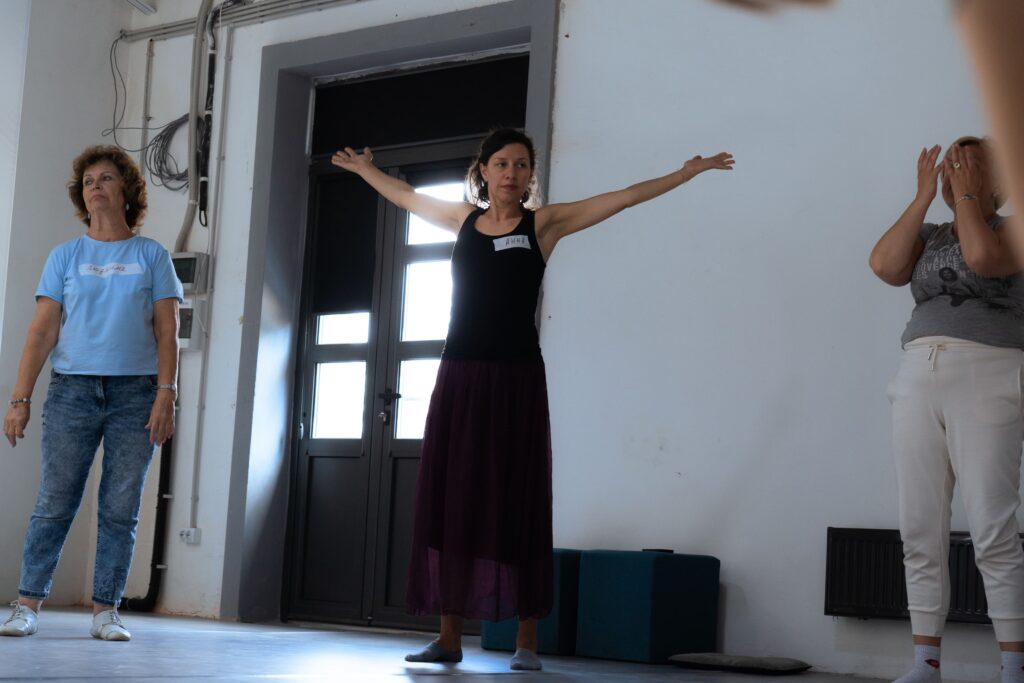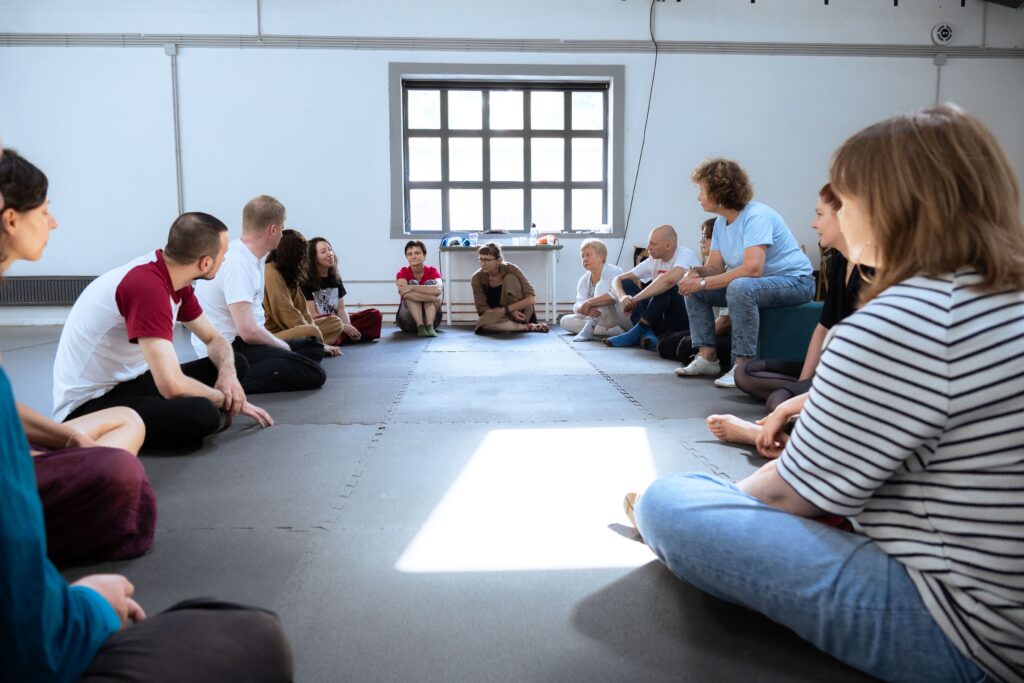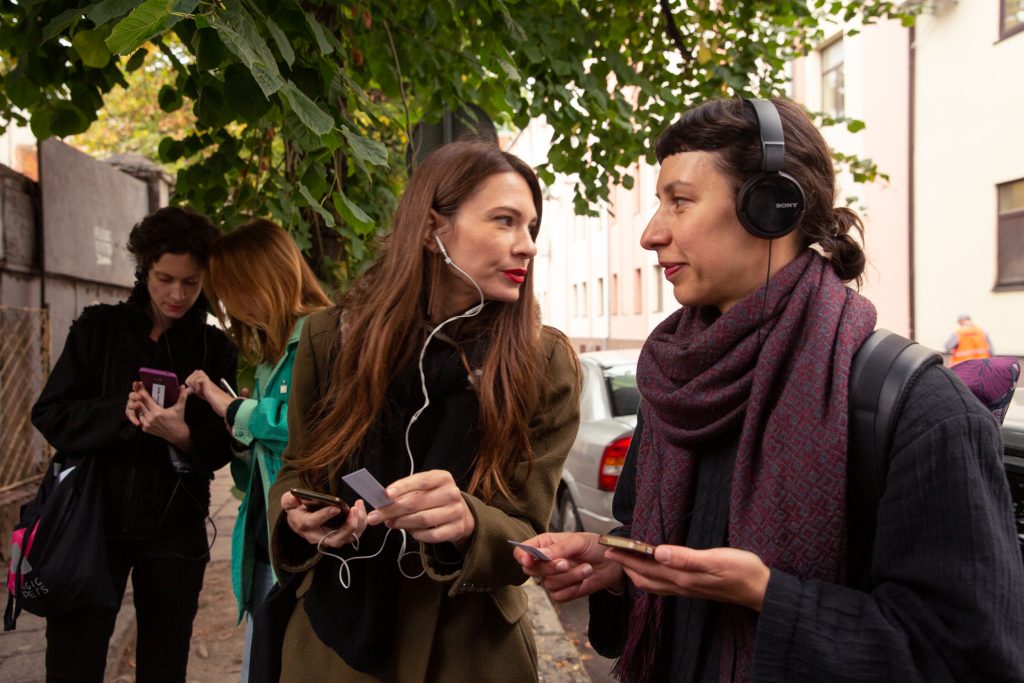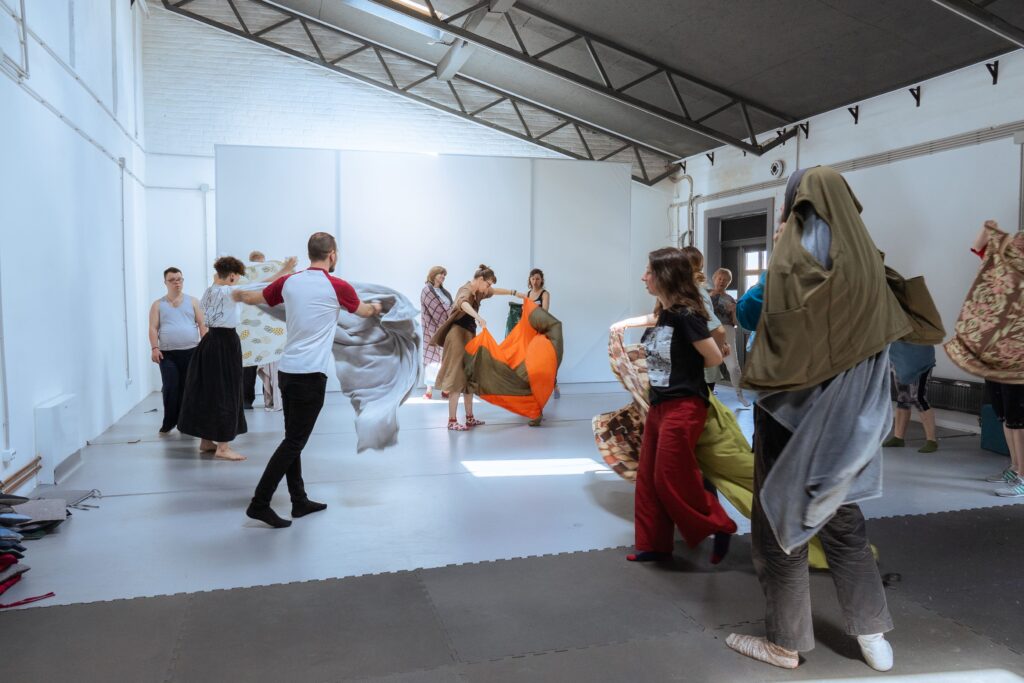Interview with the curator of the Unpacking Sound project on community-based art projects
The Jam Factory Art Center team has developed its own methodology for
working with diverse groups of people through artistic practices during its four
years of participation in the community-based MagiC Carpets program. Anna
Gaidai, Curator of Community-Based Art Projects, reveals the details of our work, highlighting the process of selecting artists to participate in the programs, as well as the ways to achieve horizontal interaction between hosting and participating artists.
Anna Gaidai is responsible for developing, curating, and coordinating art
residencies of the international platform Magic Carpets and is co-curator of the
platform`s final exhibition in the Tartu Capital of Culture 2024 program. She is a co-founder of the NGO PhotoCULT Center and co-organizer of international
festivals and exhibitions. She promotes photography through local and
international projects and educational programs. Areas of professional interest: art projects in cooperation with local communities, and interdisciplinary projects.
What is a community-based art project?
It is an art project that uses community engagement practices. It is also
known as participatory practice. In such projects, everyone who presents is a
participant in the process. Being in a group allows everyone to show their approach and vision.
People directly involved in the arts, such as artists or curators, usually lead
community-based art projects. Participatory practices in such projects include a creative component, such as collaborating to create a textile, drawing, or other work that can be tangible or intangible. The key here is the contribution made by each of the participants.
What is the main difference between community-based and traditional art projects?
An artist’s practice is still created from the author’s feelings and reflects the artist’s vision, even if it includes research on a particular community and is based on its context. Instead, when a community is involved, different voices come together to create a collaboratively woven work that incorporates multiple perspectives.
So, can we say that the community is a co-author in this case?
Yes, the idea behind MagiC Carpets and community-based projects in
general is that all the people involved are a single group: the hosts, the organization team and people from the community. Everyone’s input is accepted and everyone ends up co-authoring the result.
Describe your community outreach experience.
During the first year of the MagiC Carpets residency in 2020, I started
working with communities at the Jam Factory Art Center. During the residency “I am where I feel good” in 2020 we worked directly with teenagers from Pidzamche for four years of community projects. Then in 2022 – with families who have lived in the city for a long time or who have moved here because of the war. This year we will be working with the community of Pidzamche. These are adults who have lived here since birth, who moved here from other towns and settled here a long time ago, or who have recently moved here because of the war.
In 2021 we worked on an archive of interviews with elderly people who
used to work in the Pidzamche factories during the residency “Tracing the memories of Pidzamche”. The invited artists created an exhibition and an audio guide with excerpts from the recorded stories. We invited the community to the final presentation and used their memories in the art project. For this reason, it can be described as an indirect form of working with the community.
How do community projects get started: with a format or at the request of the
people?
Working with communities can be done in different ways. The ideal way to
work is to know from the very beginning who your community is and what it is
that unites people: territory, views, a specific need, etc. Then you can start to build on what people want and start to program. Rather than focusing on a specific, already established group, we took a different approach at the Jam Factory Art Center. Our local community of the inhabitants of Pidzamche is not a stable group of people who identify themselves as a community. Therefore, in our projects, we still start from generalized ideas and needs. We then communicate with the participants, asking and listening to what they come up with.
How has your curatorial approach and focus on community engagement changed since the full-scale invasion?
It was important for me to understand what the priorities of the institution
were and how those goals intersected with the needs of the community during the first residency in 2020. At that time our focus was on the introduction of
contemporary art to the residents of the neighborhood. The focus shifted to what was happening to us personally after the full-scale invasion.
For example, what happens to the psychological state and how art can help
to cope with difficult experiences is something we have been focusing on for the past two years.
We create a safe circle for sharing and experiencing those states or
emotions that are difficult to do on one’s own. We offer practices as keys or
tools. You can try them out with the artists and then apply them on your own.
We do this through participatory practices in a circle where everyone can
have a conversation about their condition and expectations. We don’t just start working on the program. We first get in the mood and get to know each other. At the end of the program, we also talk about how our condition has changed. These are some of the important practices in community processes and even in working with colleagues.
How do you select artists for community work? Does the team have a specific set of criteria for the residents?
The community we will be working with is a function of who we invite to be
part of the project. First of all, they must be experienced in working with groups and separately with the segment we have chosen to work with: teenagers, children, mixed groups, etc.
Secondly, we try to consider the methods used by the artists. For example,
this year we are working with voice and singing. So, we invited artists who have
practical experience working with sound in groups or alone.
Another factor is that we create multidisciplinary projects where artists from
different practices can work in the same process. This is why it is important to us that some of the Unpacking Sound residency hosts are musicians. Others, for example, have not worked with voice, but are interested in exploring how human sound can be revealed through their media.
How do you do the cross-media work in a project?
This is a very interesting process, but also a difficult one. First of all, if the
artists are unfamiliar with one another, they don’t have a clue about their
colleagues’ approaches. Secondly, to understand each other better, it takes time and many meetings together.
It takes several months to develop a multidisciplinary approach, to understand how and what can be combined, where the host is involved on his own, and where the co-hosts are involved.
It is an aid to the development of the internal logic of all the meetings in
advance. For example, this year we have planned eight meetings with the
community in which the themes are not isolated but flow from one to the other. We are working on trust, then on security, then on birth, and so on. This creates an internal line that connects the presenters. It helps them understand how they can get involved and what they can bring to the process. Within the general concept, the artists themselves will come up with themes. And it’s very interesting to see how they take those impulses from each other. What they suggest and how they undermine certain approaches.
How do you ensure that all the group members are included during the class?
Every residency and even every day of the residency are different. For
example, we use movement exercises that create a certain dynamic and engage the participants when we work with parents and children. It’s good to have a structured plan. But it’s also good to be flexible and to shorten or reformat exercises that don’t work for part of the group. People are different, and we need to pay attention to the group’s state. We need to observe if some people are scattered or if we need to change some practice to one that helps everyone come together.
We choose exercises that are accessible to everyone. They do not require
special knowledge or skills. We try to get people involved in creative activities,
such as drawing or singing, in a simple way. We emphasize not how to do it
beautifully or correctly but how to express my current state.
Our rule is no grades, which helps people be more courageous in their
participation. Even those adults who used to take their children to a class using this classical approach and stayed away from them later began to join in practice. Because they saw that they could do it, that it was interesting, and, most importantly, that they enjoyed doing these practices together with a child.
How do you achieve equality between the artists in charge and the
participants?
The multidisciplinary process helps to build horizontal interaction when we
invite different artists, and they become participants in new practices led by other residents. The person who was the leader today will become the same participant as everyone else the next time around.
It’s important when community-based projects involve a transfer of
leadership in the process. The program’s design is with the expectation that, at
some point, there will be a transfer of leadership to other people who have
something of themselves to offer. This practice of sharing builds confidence and courage and creates a safe circle where you can work on qualities that may be difficult to show in other social circles.
The openness of the artists, who come from the position of “I don’t teach,
I’m the one who shares and learns”, helps a lot. The facilitators listen a lot. They follow the participants a lot. It creates a more democratic atmosphere when an artist comes to share and learns something new.
As a curator, how do you balance the artists’ artistic vision and the community’s needs and desires?
For me, it is important to develop a methodology at the beginning of the
project when we ask ourselves: who is our community, what are their needs, what are we doing for them, and why? And it becomes anchored for us, against which we try to measure everything we’re doing. Is the program we’ve come up with going to help achieve those goals and help the community change for the better?
What do you see as the long-term effects of community-based projects?
A new memory is formed in our brains and bodies that gives us the courage
to work together in different circles, societies, and circumstances once we try such practices as participants, organizers, or artists. These are very eye-opening experiences that help you to embrace diversity, listen to different opinions, find where they overlap, and create something together.
What is the outcome of a community project?
It is the process that becomes the key. But the material result may or may
not be. It is already a good result if we walk this path together.
I firmly believe that community projects should be presented through
engagement practices where everyone who sees the results is a participant. This is a good way for people to have a first-hand experience of what community-based art projects are like.
For example, the Mystetskyi Arsenal exhibited ponchos created during our
How We Are Together residency in the Forms of Presence exhibition. The
exhibition also included ponchos created during the workshop. The artist, Yurii
Kruchak, had already made these ponchos for another community. This helped to understand the process of co-creation better. This would not have been possible just by looking at the poncho.
It is good that there are spaces for such presentations and that artists are
interested in such practices. The war has partly accelerated this process. Artists are forced to turn to new forms because they cannot access their studios, for example. One of how artists and curators can expand their practice is through art-oriented projects. This is why we are organizing a professional workshop, “How we are together,” to share our experiences and inspire colleagues to be part of practices.





